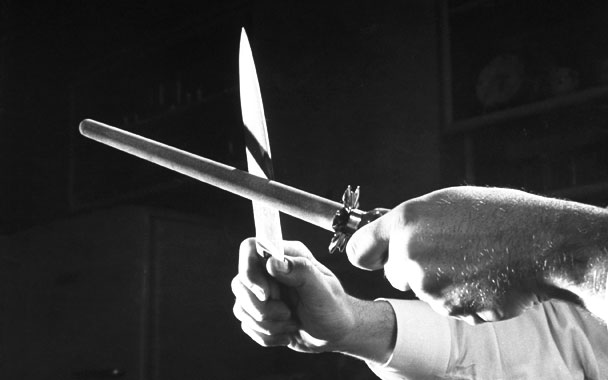In the classic, if historically inaccurate, movie Becket, the arrogant barbarism of the court of King Henry II is underscored by its riotous style of banqueting. The knights and lords mock the fork as an effete novelty and devour whole roasted animals like children gobbling ice cream. In reality, no era in culinary history was so precise and rule-bound as the European Middle Ages. There were whole books in several languages dedicated to how to carve meat—and in addition to dispensing practical advice, they also offered tips on presentation and style.
The definitive English Boke of Kervynge, written in the fifteenth century, is addressed to the highest-level servants in grand households. The complex rules extend to what verb is appropriate to describe the dismemberment of each individual animal. As with English collective nouns (a “gaggle” of geese but a “pride” of lions), each species has a special term. The Boke of Kervynge begins with a list of animals served at table and the imperative form of their appropriate carving verb. We should imagine the butler or pantler giving orders to skilled underlings (or the orders might come from the lord himself if he is particularly well-informed). Some examples (from a list of forty commands):
- Disfigure that peacock
- Tranche that sturgeon
- Splat that pike
- Barb that lobster
- Thigh that pigeon
- Unbrace that mallard
- Display that crane
- Tame that crab
I’ve tried this at home and at least it works as a self-motivating technique when faced with a tricky bird or fish. “Wheel that pizza” or “crowd that sushi” are possible updates.
Crab was and remains particularly difficult. Crack-it-yourself, extractor forks and bibs were not recognized options in the Middle Ages. The Boke of Kervynge is deceptively simply as it instructs the carver to “break him asunder into a dish” [late medieval English had the disconcerting custom of referring to food animals as “him”], make the shell clean and put in the stuff again.”
Not much is said about roasts from domestic animals. Beef, pork and chicken did not have the prestige of game, nor the necessity (because of fasting days) of fish. Compared to creatures with intricate bones (game birds), exoskeletons (lobster, crab) or just complicated morphology (lampreys, coneys), carving a mere roast beef was a beginner’s task.




 Pinterest
Pinterest


